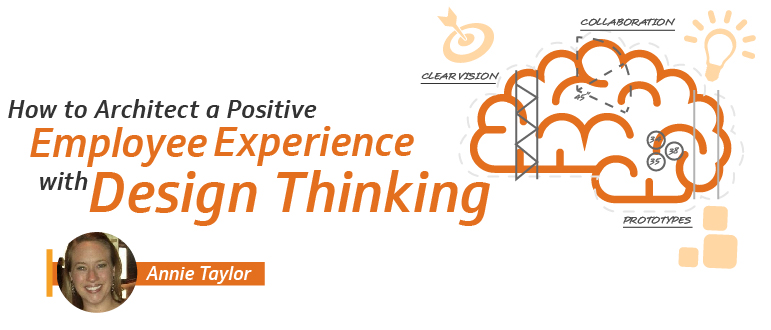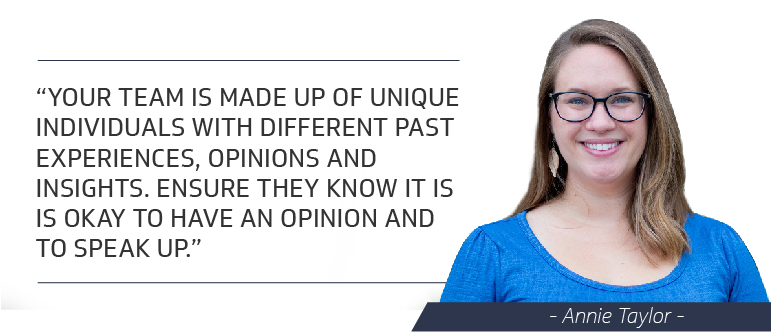
PUBLISHED APRIL 16, 2018
How Design Thinking Can Improve the Employee Experience
Managers often don’t receive formal leadership training. We learn as we go, fine-tuning the way we hold meetings with our direct reports, coming up with new ways to increase collaboration, and learning what motivates (and demotivates) each employee. We aim to give enough guidance to unleash creativity, individuality and diverse thought – and avoid being the dreaded micromanager, breathing down our employees’ necks.
Design thinking helps create an employee experience that engages and inspires. Deloitte explains: “The idea is to move from a process-driven mindset to a mindset that always begins with the experience for the HR customer—who could be a candidate, employee, contingent worker, or even alumni. So, for example, instead of thinking in process terms, ‘What do we need new hires to do on their first day?’ HR thinks in experience terms: ‘What do we want a new employee’s first day to be like?’”
Annie Taylor, Kforce Senior Organizational Development Specialist and Human Resources Partner, is passionate about using design thinking to foster a positive employee experience. We sat down with Taylor to discuss how leaders can apply quick, iterative design thinking concepts into their everyday management styles to excite and engage employees.
Annie, why are organizations embracing design thinking to create a positive employee experience?
HR departments in organizations who deliver the highest value are almost five times more likely to utilize design thinking as compared to others, according to a survey by Deloitte. Statistics like that cause HR leaders and managers to take notice.
Integrating design thinking into one’s leadership style prioritizes the employee experience and pushes us to create processes focused on the employee. It gives us a framework to help employees improve and encourages them to question what they are being asked to do. The quick iterative process of design thinking gives employees the ability to adjust the way they work and to do their jobs efficiently.
How can managers take the lead in incorporating design thinking?
Managers will need to get to know their people as individuals, and discover what makes them tick. To build a culture of iteration and agility requires tapping into each team member’s strengths and perspectives on a regular basis. Listening and connecting ensures that each employee’s needs are being met, and that they feel part of a larger whole.
Developing certain traits empowers managers to take the lead in embedding design thinking concepts into the organization. Thinking of new ways to collaborate, acting as a catalyst for creativity, and seeing the world in terms of problems and products are just a few of these key characteristics.
Why is diversity of thought and collaboration important to shaping the employee experience?
Setting a clear vision, and then trusting the team to come up with the best process, allows leaders and their teams to be innovative and efficient. We are so quick to rely on “the way things have always been done” that innovation and iteration are often stifled.
Managers, make it clear to your employees that diversity of thought is highly valued, and ensure everyone has a voice. Let them become part of the strategy setting. Giving ownership of processes to employees almost always guarantees success because they are transformed into owners – rather than doers.
It is critical that managers are humble and acknowledge that they don’t have all the answers. They should encourage respectful debate on the team and the challenging of the status quo.
What are the biggest obstacles in adopting design thinking?
Teams take time to adjust. If they are used to the status quo, they may resist change, even if the need for it is apparent. One of the greatest benefits of design thinking is that it gives you a chance to shake things up and try new ideas before you get so far down the road that you can’t course correct. This pace can be uncomfortable and too fast-paced for some, so the manager needs to set expectations and continually communicate to their team team why they are changing their approach.
How can managers have effective one-on-one meetings with employees?
As a manager, you should be encouraged to get to know your team on a deep, individual level and treat them like the ultimate customer. Knowing the skills, backgrounds and experiences on your team will allow you to motivate employees to tap into resources when innovation, design and optimization are most important. Focus on their motivators and what gets them excited.
You’ve talked about letting employees soar, and not expecting them to fall.
Most professionals you meet want to be a thriving employee. They want to contribute to an organization’s innovation. Managers should give employees space and freedom to own tasks, so they are in a position to innovate.
Just as individual contributors need space and freedom to innovate, managers do as well. I often talk with senior leaders about helping managers create the time and space necessary to do something new. This does not mean encouraging managers to drag out deadlines; however, you should avoid old favorites when reinventing the wheel. Encourage managers to take the time to teach associates how to do the tasks someone taught them to do so many years before. Show managers how to ask their employees what they want to do more of. As employees take on more of that work, caution your managers not to micromanage.
Lastly, how do you measure the success of one’s design thinking journey?
The benefits of design thinking are not always immediately clear, but there are a few key impacts to observe. Once design thinking is in full swing, your team should be regularly facing challenges. When you survey a team that has design thinking at its core, there likely won’t be a broken process that isn’t in the process of being fixed.
You won’t hear anyone with a design thinking mindset say, “I’m not sure why I do this task, but I was told to do it, so I do.” They will challenge the why and make sure that every step in the process is meaningful and productive. With the quick, iterative nature of design thinking, teams have the freedom to learn, grow and leverage different perspectives without fear of speaking up with new ideas. With the freedom to challenge existing processes and throw all ideas out on the table, no matter how creativity is ignited, you will pave the way for employees to come up with solutions.
For those ready to reimagine their employee experience through design thinking, check out Annie Taylor’s tips on how to get started below.


There is a tendency for leaders to want a policy or playbook to rely on, but at the end of the day, they are managing people with individual lives, each with its own dynamic challenges. When managing individuals individually, approach employees as puzzles to solve. Understanding the unique variables that make up a person will only lead to a constructive solution and holistic picture.

Leaders should be encouraged to try new things, such as leveraging their network and accessing external thought leadership to gain insight. Learning from peers and from the experiences of others allows us to exchange ideas, expand our knowledge and reach higher levels of expertise. Remember, learning is a two-way street, and great things always result from diversity of thought.

Team building exercises can help facilitate the design thinking process because you get the opportunity to learn about your employees and their strengths. Exercises also give you the ability to practice and quickly iterate your message by creating situations, getting real-time feedback and then shifting your approach. Leverage your organizational development team to help facilitate “tried and true” team building exercises.
Design thinking encourages us to see our employees as customers through a quick, iterative process. Through this methodology, we can provide a differentiated experience that drives employee engagement, satisfaction and productivity. While these tips above can indeed assist you in your design thinking journey, the ultimate employee experience will be defined as you continue to prototype, pilot, test and learn.
